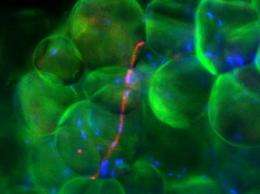Why do fat cells get fat? New suspect ID'd

- As the world fights obesity at the human level, scientists at the University of Michigan and their colleagues have made a surprising finding at the microscopic level that could help fuel that fight.
Their work helps explain why fat-storing cells get fatter, and burn fat slower, as obesity sets in. If their findings from mice can be shown to apply to humans, they may provide a new target for obesity-fighting drugs.
By studying the tiny signals that fat-storing cells send to one another, the team has shown a crucial and previously unknown role for a molecule called Sfrp5.
The results, which appear online today and will be in the July issue of the Journal of Clinical Investigation, surprised them.
In a series of experiments, the team showed that Sfrp5 influences a signaling pathway known as WNT to stimulate fat cells – called adipocytes – to grow larger and to suppress the rate at which fat is burned in the mitochondria inside them.
By stopping cells from making Sfrp5, they were able to make mice that didn't get as fat as quickly because their adipocytes didn't grow large – even when the mice were fed a high-fat diet. They even showed the impact when transplanting fat from Sfrp5—deficient mice into other mice.
The research was performed with National Institutes of Health funding in the U-M Medical School laboratory of Ormond MacDougald, Ph.D., the Faulkner Professor in the Department of Molecular & Integrative Physiology, a professor of internal medicine and a member of U-M's Brehm Center for Diabetes Research.
Working with postdoctoral fellow and first author Hiroyuki Mori, Ph.D., and colleagues, MacDougald says the team built on its previous findings about the importance of WNT signaling in fat cell development.
"WNT signaling plays a crucial role in regulating, and inhibiting, white fat cell growth and the recruitment of new cells to store fat," he explains. "But it appears that in obesity, Sfrp5 can interfere with that signaling, and may create a feedback loop that keeps stimulating production of more of itself."
He notes that the new results contradict previous work published by another group, which found essentially the opposite role for Sfrp5. A commentary accompanying the new U-M paper, by scientists from Denmark, notes the strong evidence behind the new findings and emphasizes the importance of further research on the topic.
MacDougald and his team zeroed in on Sfrp5 after years of studying WNT signaling between adipocytes. They and other teams had already seen that the amounts of Sfrp5 produced within fat tissue were higher in obese animals.
They were able to breed mice that could not make the molecule, and expected to see that these mice resisted obesity because they couldn't convert more cells into adipocytes to store excess fat from their high-fat diet.
But instead, they found that the mice without Sfrp5 did have just as many fat cells as other mice -- but that these cells didn't accumulate fat and grow bigger. As a result, the mice didn't get fat, no matter how rich their diet.
Looking more closely at Sfrp5-deficient mice, they saw a surge of activity in expression of genes related to mitochondria – the furnaces inside cells that burn fat or other fuel to power cell activity. It was as if the furnaces had been stoked when Sfrp5 wasn't present, so fat could be burned at a higher rate than normal.
"From our results, we believe that Sfrp5 is an important moderator of mitochondrial activity, the first time this has been seen for the WNT signaling pathway in adipocytes," says Mori. "This underscores the complexity of WNT signaling."
In essence, MacDougald says, Sfrp5 poses as a decoy receptor for WNT signals to bind to, keeping them from binding to the receptors on the cell surface that they otherwise would bind to. With WNT signaling reduced, cells store fat and grow larger, and don't burn it as quickly. Then, the cells produce even more Sfrp5, creating the feedback loop that perpetuates the tendency for adipocytes to accumulate lipid.
While pharmaceutical companies are already looking at WNT signaling as a possible target for drugs related to bone formation, the new findings suggest that perhaps the same signaling pathway could be a target for anti-obesity drugs.
But, MacDougald cautions, the findings need to be explored further in both mice and humans. With the obesity epidemic putting hundreds of millions of people at risk of all types of diseases, that research has a special urgency behind it.
More information: Journal of Clinical Investigation Vol. 122 No. 7, July 2012, Online ahead of print - doi:10.1172/JCI63604














